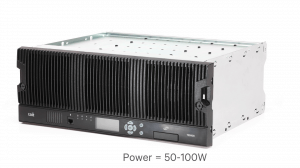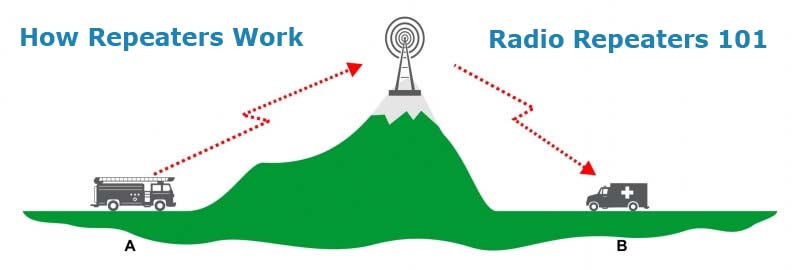How Do VHF & UHF Radio Repeaters Work ?
Images and content courtesy of TAIT Radio Communications:
Repeaters help with the problem of line of sight in conventional communications. If two radios want to communicate with a hilltop in the way, then there is no line of sight. One way to overcome this is placing a repeater (or base station) at the top of the hill. One radio communicates up to the repeater, this is called uplink, and then the repeater repeats that transmission down to the radio on the other side of the hill, this is called downlink.
However, repeaters are used even when there are no hills in the way as they are excellent for extending range. A repeater is an extremely powerful radio. Portable radios work in five watts, mobile radios work in 25 watts or more, and repeaters are even more powerful radios in the 50 to 100 watt range.

Repeaters are generally in fixed positions at particular geographical locations. This can sometimes be in their own special hut or in some type of enclosure. They have a cable connection to antenna systems, which are either mounted on steel towers or simply fixed to the top of the building.
Mobile radios and portables can take advantage of the greater power available in the larger size of the antennas. A collection of repeaters connected together provide mobile portable radio users coverage over an extremely wide area, thus extending the range of communications.
Technically speaking
A radio repeater is a combination of a radio receiver and a radio transmitter that receives a signal and retransmits it, so that two-way radio signals can cover longer distances. A repeater sited at a high elevation can allow two mobile stations, otherwise out of line-of-sight propagation range of each other, to communicate.[1] Repeaters are found in professional, commercial, and government mobile radio systems and also in amateur radio.
Repeater systems use two different radio frequencies; the mobiles transmit on one frequency, and the repeater station receives those transmission and transmits on a second frequency. Since the repeater must transmit at the same time as the signal is being received, and may even use the same antenna for both transmitting and receiving, frequency-selective filters, known as duplexers are required to prevent the receiver from being overloaded by the transmitted signal. Some repeaters use two different frequency bands to provide isolation between input and output or as a convenience.
Detailed information on Repeater Operation may be obtained from this WiKi Link

